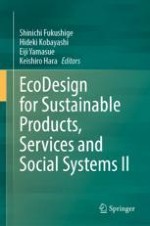2024 | OriginalPaper | Chapter
15. Energy Saving Evaluation Based on Utilizing Recycled PET Bottles in Concrete Blocks in Iran
Author : Mohammad Zolfaghari
Published in: EcoDesign for Sustainable Products, Services and Social Systems II
Publisher: Springer Nature Singapore
Activate our intelligent search to find suitable subject content or patents.
Select sections of text to find matching patents with Artificial Intelligence. powered by
Select sections of text to find additional relevant content using AI-assisted search. powered by
